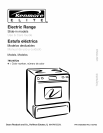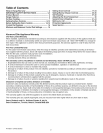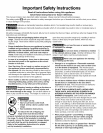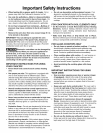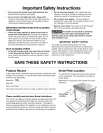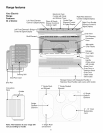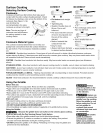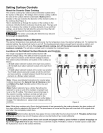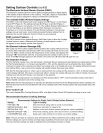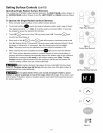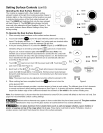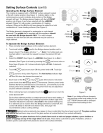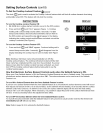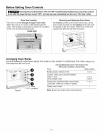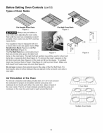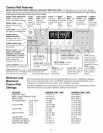
Surface Cooking
Selecting Surface Cooking
Cookware
Cookware should have flat bottoms that make good
contact with the entire surface heating element. Check
for flatness by rotating a ruler across the bottom of the
cookware (See Figure 1). Be
sure to follow the
recommendations for using
cookware as shown to the right,
Note: The size and type of
cookware used will influence
the setting needed for best
cooking results.
Figure 1
Cookware Material types
The cookware material determines how evenly and
quickly heat is transferred from the surface element to
the pan bottom. The most popular materials available
are:
CORRECT INCORRECT
W
1" t
• Flat bottom and straight
sides.
• Tight fitting lids.
• Weight of handle does not
tilt pan. Pan is well
balanced.
• Pan sizes match the amount
of food to be prepared and
the size of the surface
element.
• Made of material that
conducts heat well.
• Easy to clean.
Curved and warped pan
bottoms.
W
_ _ ----1
_iiiiiiiiiiii_iiiiiiiiii__
4,4I_
Pan overhangs unit by more
than one-half inch.
I
v
• Pan is smaller than the
element.
Always match pan diameter • Heavy handle tilts the pan.
to element surface diameter.
ALUMINUM - Excellent heat conductor. Some types of food will cause it to darken (Anodized aluminum cookware
resists staining & pitting). If aluminum pans slide across the ceramic glass cooktop, they may leave metal marks which
will resemble scratches. Remove these marks immediately.
COPPER - Excellent heat conductor but discolors easily. May leave metal marks on ceramic glass (see Aluminum
above).
STAINLESS STEEL - Slow heat conductor with uneven cooking results. Is durable, easy to clean and resists staining.
CAST IRON - A poor heat conductor, but will retain heat very well. Cooks evenly once cooking temperature is reached.
Not recommended for use on ceramic cooktops.
PORCELAIN-ENAMEL on METAL - Heating characteristics will vary depending on base material. Porcelain-enamel
coating must be smooth to avoid scratching ceramic cooktops.
GLASS - Slow heat conductor. Not recommended for ceramic cooktop surfaces because it may scratch the glass.
Using the Griddle
Before first use:
• Wash Griddle in hot soapy water. Rinse and then dry completely.
• Apply a thin coat of vegetable oil to the entire surface (front and back of griddle).
• Preheat your oven to 350°E Place the griddle on the upper rack in your oven.
• Bake griddle for 1 hour at 350°E then turn oven OFF and let cool before removing.
• The surface may appear to have a tacky feel to it from this seasoning process. If desired,
wash the griddle in hot soapy water, rinse well, and dry completely.
After each use:
• To prevent rusting, store in a dry place and keep uncovered.
• After each use, clean with a stiff brush and hot water only.
• DO NOT CLEAN GRIDDLE IN DISHWASHER.
• Dry immediately and apply a light coating of vegetable oil to griddle before storing.
Using the Griddle:
Because the griddle does not lay flat on the ceramic glass cooktop,
IlkVAI'.Ze];ilt;1_,i
it will not work with the Pan Sensing (Sensa Cook) feature.
• Place either side of the griddle centered over the left side bridge element.
• Preheat the griddle for 5 minutes on medium to medium low setting. Slow preheat
ensures even heat distribution during the cooking process.
• DO NOT preheat the griddle on HI setting. Preheating on HI may warp the griddle and
prevent even heat distribution.
Always
place the griddle on the
cooktop before turning
on the element.
Always use
potholders to remove the
griddle from the cooktop.
Allow the griddle to cool
before removing. Do not
set hot griddle on
surfaces that cannot
withstand high heat such
as countertops.
Besure the
griddle ispositioned
correctly and is stable
before use to prevent hot
spills and possible burns.
;;:IIIIIC



